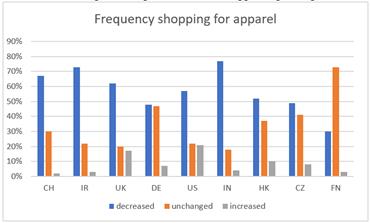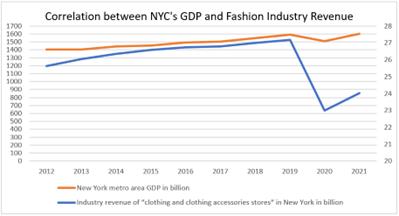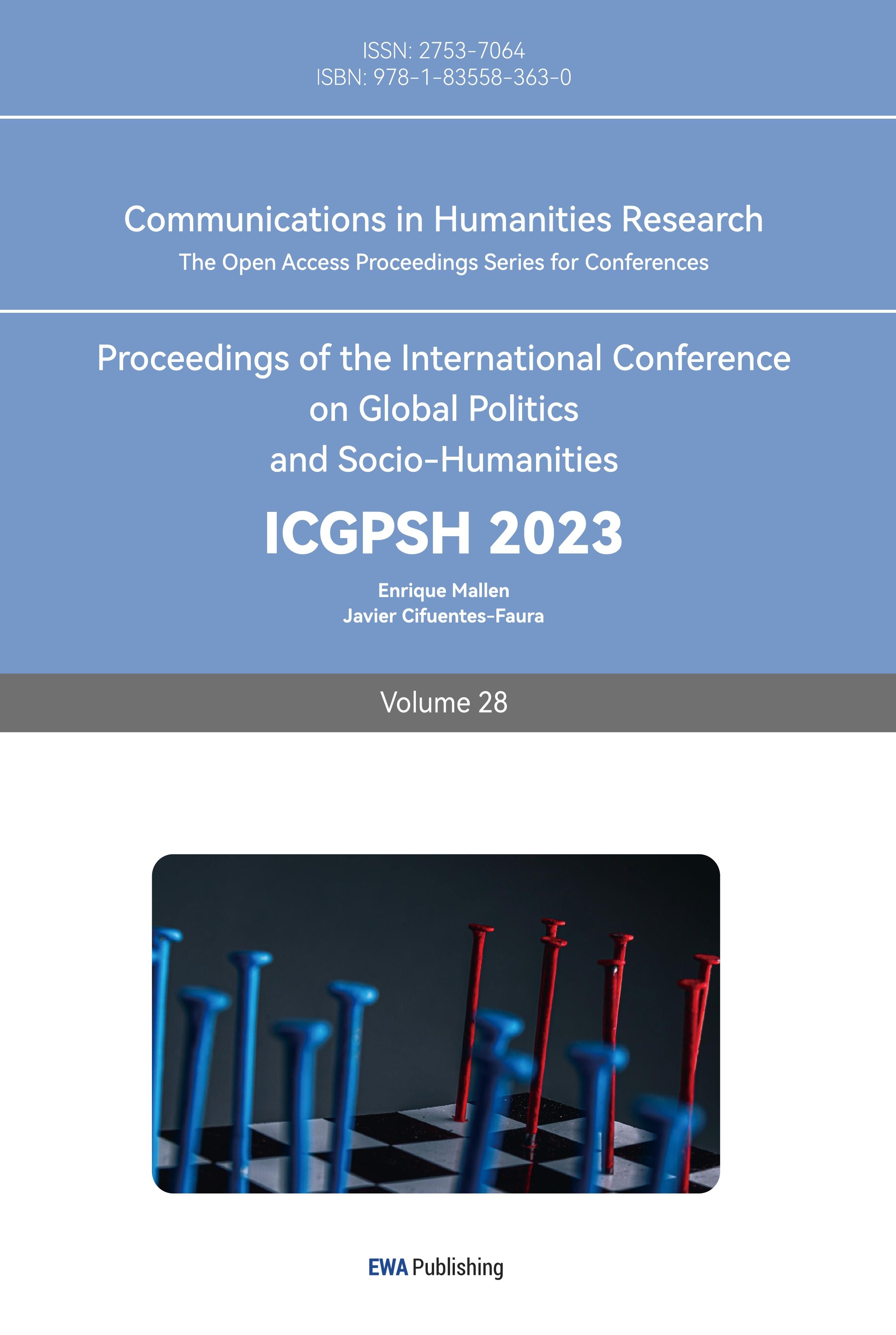1.Introduction
The relationship between a city's economy and its fashion industry is complex and interconnected, with each influencing the other in significant ways. This paper aims to examine the interplay between these two entities, highlighting the positive impact that a thriving fashion industry can have on a city's economic development and vice versa. By analyzing various economic factors that shape fashion development and the fashion industry's role in promoting economic growth, I seek to demonstrate the mutually beneficial nature of this relationship.
2.Literature Review
The 2023 Met Gala has just ended. People widely consider New York, London, Milan, and Paris as the ‘Big Four fashion capitals’ because of these annual big fashion shows. Of the highly advanced economy of these cities, some people say they do have supported their development of fashion industries. On the other side, because of the large amount of profit companies gain from fashion exports, some also suggest that it is the fashion industry that promoted these cities’ economic development. In fact, the economy and the fashion industry have a mutual influence on each other. Fashion, also known as fad, refers to a lifestyle or behavior pattern that is generally popular in society or a group in a certain period of time and is imitated by most people. It can be reflected in both material life (like clothes) and spiritual life (like cultural activities and entertaining shows). Recent years’ studies have included several factors that states how the economy and fashion industry effect mutually. According to the report, The Economic Impact of the Fashion Industry, 2019, ‘fashion is a $2.5 trillion global industry. In the United States alone, consumers spent nearly $380 billion on apparel and footwear in 2017.’ [1].
Talking about the U.S., its annual economic impact is about $600 million more than the Super Bowl [2]. In this article, the high income of the fashion industry comes from different aspects, including a wide range of job fields along with a large number of people taking up these jobs.
According to the text, I got the following points to support my idea. Fashion provides rich employment opportunities for people in society, thus promoting the growth of per capita income, which effectively proves the view that fashion promotes economic development. New York, an economically developed city, is also the four major fashion capitals, which supports the view that the fashion industry and the economy are interdependent. In addition, the text also mentions the impact of other factors on the fashion economy, such as people's tastes and expectations and related economic policies. Throughout the fashion industry, economic development is an essential part. If the relationship between the economy and the fashion industry is ignored, it will not only directly affect the development of the fashion industry but also may cause various contradictions and problems, thus affecting the entire economic trend. The research in this field lacks the analysis of other cities with developed fashion industries, which should make the research conclusion more general and persuasive.
To sum up, this paper makes a breakthrough in the relationship between economic development and the fashion industry and believes that the two are interdependent and mutually influencing, and future development should pay attention to and improve the relationship between the two.
3.Methodology
To examine the relationship between a city’s economy and its fashion industry, this paper relies on a combination of quantitative and qualitative data resources. Economic indicators such as personal income levels, job employment rates, and population growth are analyzed to understand their influence on fashion development. Additionally, case studies, economic reports, and industry statistics are used to demonstrate the impact of the fashion industry on a city’s economy.
4.NYC Case Study
To be more specific, let’s take New York City’s fashion industry as an example. The 1960s are known for their iconic fashion trends, which were heavily influenced by Lady Jacqueline Kennedy. Fashions of this decade were energetic and inventive and continue to be popular today [3]. With the support of building infrastructures like schools, New York has established several art schools for designers and fashion managers, such as Parsons, RISD and FIT. With these specialized schools, New York educates students majoring in fashion over 20,000 per year [4]. The fashion industry has gradually been established. Currently, its apparel industry has spread overseas. NYC's regional economy demonstrates exceptional strength, with a GDP of $1,281 billion, establishing it as the most influential economic area in the United States. Besides, NYC's per capita income is impressively high at $30,200, surpassing the national average of $26,708. The labor force of the city ranks 6th among all regions in the United States. This emphasizes the efficiency and effectiveness of the workforce in driving economic growth and promoting technological development. Technological advancements have transformed the apparel industry in two major ways. Firstly, consumers now have instant access to information, leading to a demand for faster and more customized apparel. It was predicted that by 2016, online sources will influence over 66% of apparel sales. Secondly, according to e-marketers, e-commerce has become a vital channel for industry players, representing around 6% of total retail sales and growing steadily. This shift presents both opportunities and challenges, as established brands can easily access new markets [5]. As the fashion industry of NYC gradually advanced, it also facilitated the economy. The annual event, New York Fashion Week, had approximately 150,000 attendees in 2017. It occurs during the spring and fall seasons, generating an annual total income of nearly $600 million [6]. According to the New York City Economic Development Corporation (NYCEDC), NYC accommodates over 900 fashion firms at its headquarters. With annual retail sales surpassing $18 billion and tax revenue reaching $2 billion, it stands as the largest retail market nationwide [7]. Absolutely, these incomes comprise a large percentage in NYC’s GDP, so the economy and fashion industry are stimulating mutually with each other.
5.Economic Influence on the Fashion Industry
To start with, the personal economy level can influence the fashion industry through consumer consumption. According to the principle, money inflow equals money outflow. Consumer consumption will decrease as the disposable income decreases. With higher personal income and labor force participation rate, people’s purchasing power increases apparently. Based on the article ‘Factors That Influence Consumers’ Behaviors in Fashion Market’, individuals with a consistently high income have already fulfilled their essential needs, allowing them to prioritize the acquisition of luxurious items to fulfill their self-esteem desires. These goods serve as symbols of social standing and facilitate the garnering of admiration and esteem from others [8]. A typical example of this can be the economic fluctuation during the COVID-19. According to the article, ‘Fashion consumption during COVID-19: Comparative analysis of changing acquisition practices across nine countries and implications for sustainability’, in June 2022, the spending on fashion products across nine countries decreased based on figure 1 [9].

Figure 1: Descriptive statistics for apparel spending.
The disability to go out has led many off-line shops, restaurants and the tourism industry shut down, causing a lot people to lose their jobs and cut off their financial income. Without financial support, they are unable to buy any products, especially when it comes to pursuing the fashion trends, which is generally considered as a kind of entertainment. Through Figure 1, during the pandemic, the shop frequency of CH and IR decreased by nearly 70%, IN decreased by about 78%, and others decreased between 50%~60%. With less products being sold, the fashion industry had been struck hard. Apart from that, the fashion industry could also be affected by job employment and income level through differences in fashion preferences. People with higher income and better job are more likely to keep up with the trend, meanwhile purchasing more luxuries. With these economic supports, people are able to enjoy the extra material life they are looking for.
Other factors, including population growth and improvements in transportation that depend on economic development also facilitate fashion progress. A strong economy allows individuals to have purchasing power. With more people beginning to pursue fashion, different people can lead to the emergence of diverse fashion subcultures and trends. Besides, the spending on constructing the transportations give more opportunities to push the movement of fashion goods and service, to expand the market to overseas and rich the industrial chain.
6.Fashion Industry Influencing the Economy
When it comes to the influence of fashion on the economy, we can include the following sides.
First, when the economy builds enough basin for the city to develop a fashion industry, fashion can provide job opportunities reversely to contribute to the city’s labor market. A large range of jobs, including computer occupations, market research analysts and marketing specialists, production, planning, and expediting clerks, designers, and so on, undoubtedly stimulate the gross economic income of citizens. In addition, fashion also plays an important role in attracting people for local tourism and revenue generation. Take the Fashion Weeks as an example. Fashion pursuers will go to see the shows while having a trip in the city. Each person’s spending is included largely speaking, from booking the plane ticket and attending the Fashion Week to the spending of going to tour sites. To be more specific, it also includes dining and accommodation. Here, even if a person travels for a week, it will cost about $7,000. If we take this by 230,000 according to its number of visitors, about 300 million dollars at least will be received by the city holding the fashion week activity. Besides that, fundamentally speaking, people participate in the activities and purchase products because of the impact of fashion brands and flagship stores. For instance, Chanel has an extensive sales network around the world, originating from France. It brings a lot of export revenue to France. At the same time, Chanel also actively participates in various public welfare and charitable activities and makes a positive contribution to society it has funded many cultural and artistic projects, and supported many charities and social welfare causes. The global influence of this brand has brought lots of economic profits from France to Paris, and Chanel's products and image represent French fashion and luxury to the world.
Table 1: Data of NYC’s GDP & NYC apparel industry revenue.
Year |
2012 |
2013 |
2014 |
2015 |
2016 |
Industry revenue of “clothing and clothing accessories stores “ in New York in billion |
25.63 |
26.03 |
26.35 |
26.58 |
26.73 |
New York metro area GDP in billion |
1402 |
1405 |
1443 |
1453 |
1490 |
Year |
2017 |
2018 |
2019 |
2020 |
2021 |
Industry revenue of “clothing and clothing accessories stores “ in New York in billion |
26.79 |
27.01 |
27.19 |
22.99 |
24.02 |
New York metro area GDP in billion |
1502 |
1550 |
1590 |
1509 |
1600 |

Figure 2: Correlation between NYC's GDP and Fashion Industry Revenue.
7.Conclusion
The city’s economy and the development of its fashion industry have a mutually beneficial relationship, as shown in Figure 2. Specific data on the revenue of NYC’s fashion industry revenue and NYC’s GDP each year is shown in Table 1. We can see that fashion contributes to the city’s economy by providing employment opportunities revenue, and attracting tourism. In turn, a thriving fashion industry enhances the city’s global reputation and attracts investment. The industry’s presence promotes innovation and entrepreneurship, driving advancements in technology and sustainability. This contributes to economic growth and creates a diverse range of creative opportunities. The city’s economy provides a supportive environment for the fashion industry to flourish, while the industry, in turn, enhances the city’s economic competitiveness and cultural vitality. Together, they contribute to the city’s positive cycle of economic prosperity and global influence.
References
[1]. Carolyn B. Maloney (2019), The Economic Impact of The Fashion Industry, page 1.
[2]. Amir Somoggi (2023), Super Bowl's economic impact exceeds US$ 600 million. An analysis far beyond the most expensive 30 seconds on TV.
[3]. Valerie Forgeard (2023), What Were the Beauty Standards in the 1960s: From Elegance to Experimentation.
[4]. JEC Democratic staff calculations based on enrollment data from Parsons, FIT, and Pratt.
[5]. E-Marketer. (2013). Retail Ecommerce Set to Keep a Strong Pace Through 2017, Retail & Ecommerce. E-Marketer. Retrieved 5, 2015.
[6]. Vivian Hendriksz (2017), Key Numbers: How much money New York Fashion Week makes.
[7]. NYC Fashion Industry Generates $2 Billion Annually (2015), Joint Economic Committee (JEC) Ranking Democrat Carolyn Maloney (D-N.Y.).
[8]. Xiang, X. (2021), Factors That Influence Consumers’ Behaviors in Fashion Market. Open Journal of Business and Management.
[9]. Katia V (2022), Fashion consumption during COVID-19: Comparative analysis of changing acquisition practices across nine countries and implications for sustainability, Apparel spending 4.22.
Cite this article
Zhang,Y. (2024). The Mutual Relationship Between the City’s Economy and Fashion Industry. Communications in Humanities Research,28,99-103.
Data availability
The datasets used and/or analyzed during the current study will be available from the authors upon reasonable request.
Disclaimer/Publisher's Note
The statements, opinions and data contained in all publications are solely those of the individual author(s) and contributor(s) and not of EWA Publishing and/or the editor(s). EWA Publishing and/or the editor(s) disclaim responsibility for any injury to people or property resulting from any ideas, methods, instructions or products referred to in the content.
About volume
Volume title: Proceedings of the International Conference on Global Politics and Socio-Humanities
© 2024 by the author(s). Licensee EWA Publishing, Oxford, UK. This article is an open access article distributed under the terms and
conditions of the Creative Commons Attribution (CC BY) license. Authors who
publish this series agree to the following terms:
1. Authors retain copyright and grant the series right of first publication with the work simultaneously licensed under a Creative Commons
Attribution License that allows others to share the work with an acknowledgment of the work's authorship and initial publication in this
series.
2. Authors are able to enter into separate, additional contractual arrangements for the non-exclusive distribution of the series's published
version of the work (e.g., post it to an institutional repository or publish it in a book), with an acknowledgment of its initial
publication in this series.
3. Authors are permitted and encouraged to post their work online (e.g., in institutional repositories or on their website) prior to and
during the submission process, as it can lead to productive exchanges, as well as earlier and greater citation of published work (See
Open access policy for details).
References
[1]. Carolyn B. Maloney (2019), The Economic Impact of The Fashion Industry, page 1.
[2]. Amir Somoggi (2023), Super Bowl's economic impact exceeds US$ 600 million. An analysis far beyond the most expensive 30 seconds on TV.
[3]. Valerie Forgeard (2023), What Were the Beauty Standards in the 1960s: From Elegance to Experimentation.
[4]. JEC Democratic staff calculations based on enrollment data from Parsons, FIT, and Pratt.
[5]. E-Marketer. (2013). Retail Ecommerce Set to Keep a Strong Pace Through 2017, Retail & Ecommerce. E-Marketer. Retrieved 5, 2015.
[6]. Vivian Hendriksz (2017), Key Numbers: How much money New York Fashion Week makes.
[7]. NYC Fashion Industry Generates $2 Billion Annually (2015), Joint Economic Committee (JEC) Ranking Democrat Carolyn Maloney (D-N.Y.).
[8]. Xiang, X. (2021), Factors That Influence Consumers’ Behaviors in Fashion Market. Open Journal of Business and Management.
[9]. Katia V (2022), Fashion consumption during COVID-19: Comparative analysis of changing acquisition practices across nine countries and implications for sustainability, Apparel spending 4.22.









